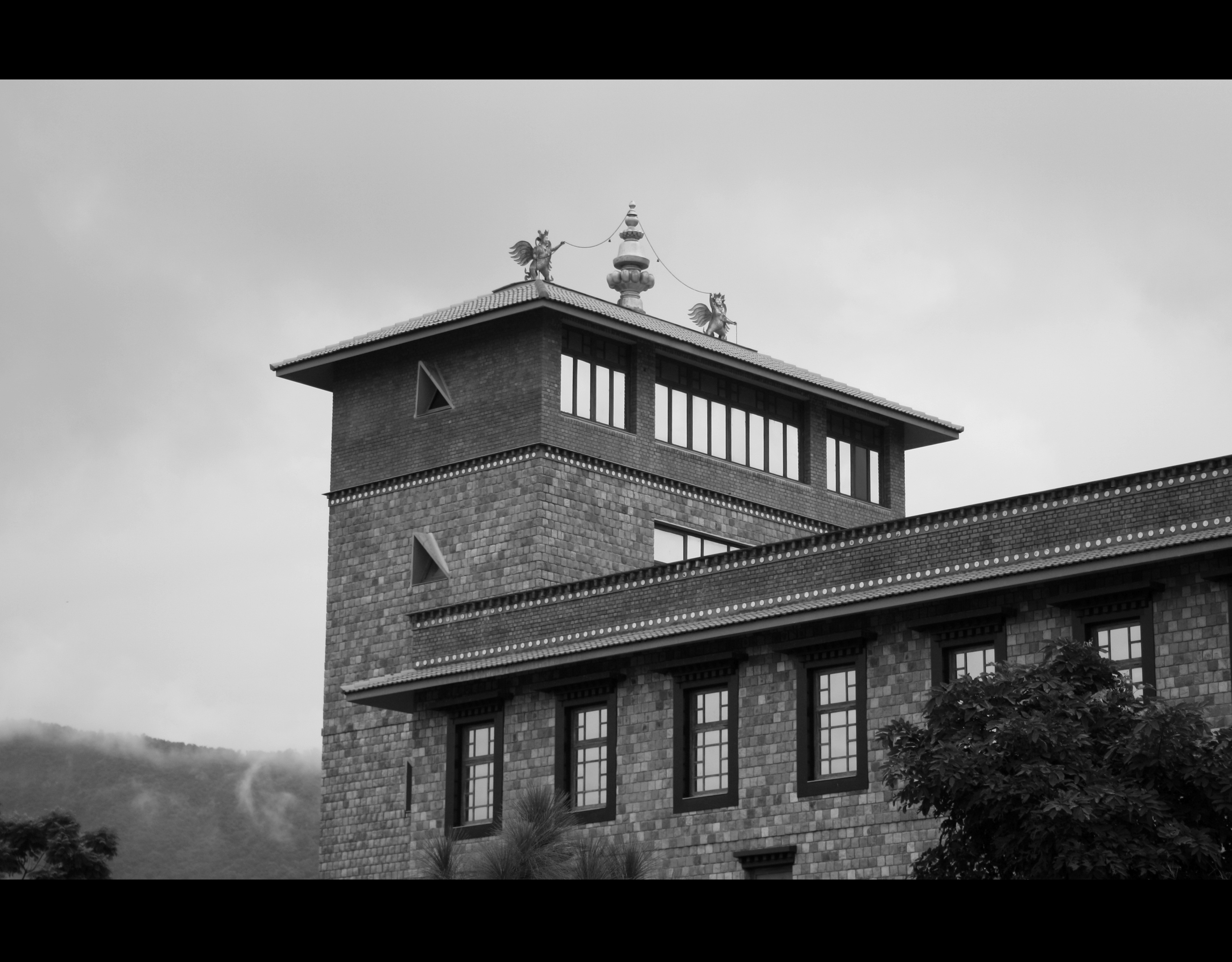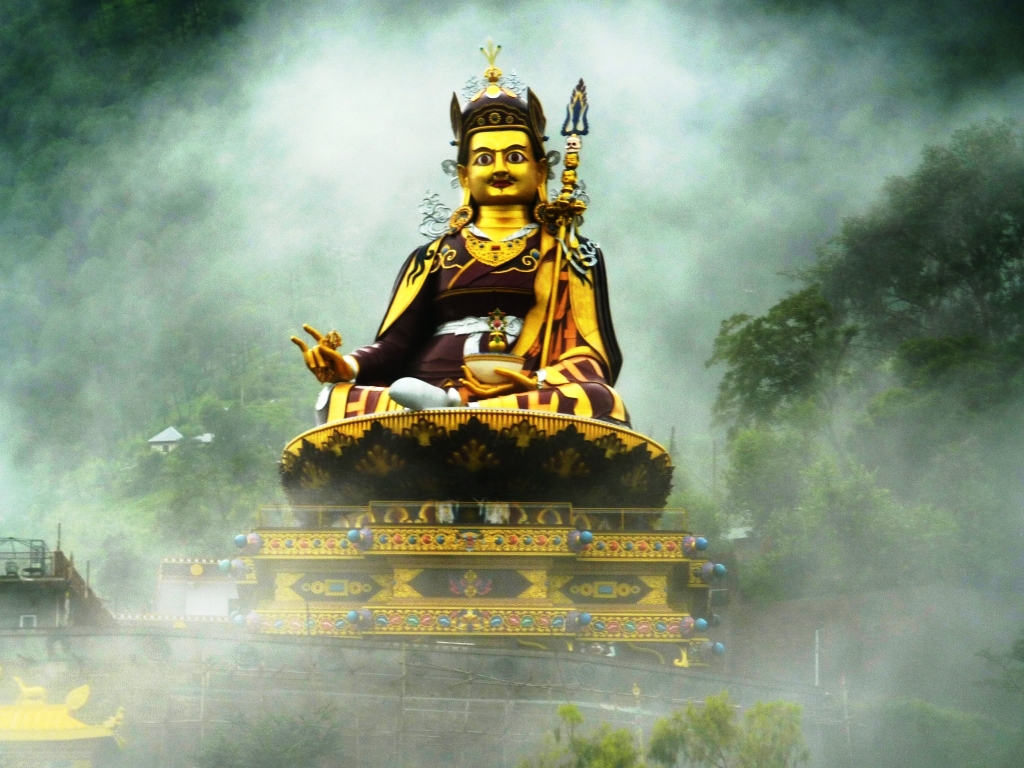|
Buchu Monastery
Buchu Monastery, Buchu Sergyi Lhakhang, or Buchasergyi Lakang Monastery () is a temple in an ancient monastery about 28 km south of the modern town of Bayi, which replaces the old village of Drakchi, in Nyingchi County of eastern Tibet, China. Description The two-storied monastery has a striking golden roof which can be seen from afar. There have been only eight monks living here recently. Previously the temple contained images of the Eight Manifestations of Padmasambhava, and the upper floor had eight images of Amitayus which have not yet been restored. The lower part of the large Padmasambhava downstairs survived, and still contains the ''zungjuk'' or mantra-core. History The original buildings here were built during the 7th century reign of King Songtsen Gampo. It was created as one of the eight "demoness-subduing" temples, and was constructed according to geomantic theory on the right elbow of the ogress who represented Tibet. It is the oldest Buddhist structure in the e ... [...More Info...] [...Related Items...] OR: [Wikipedia] [Google] [Baidu] |
China
China, officially the People's Republic of China (PRC), is a country in East Asia. With population of China, a population exceeding 1.4 billion, it is the list of countries by population (United Nations), second-most populous country after India, representing 17.4% of the world population. China spans the equivalent of five time zones and Borders of China, borders fourteen countries by land across an area of nearly , making it the list of countries and dependencies by area, third-largest country by land area. The country is divided into 33 Province-level divisions of China, province-level divisions: 22 provinces of China, provinces, 5 autonomous regions of China, autonomous regions, 4 direct-administered municipalities of China, municipalities, and 2 semi-autonomous special administrative regions. Beijing is the country's capital, while Shanghai is List of cities in China by population, its most populous city by urban area and largest financial center. Considered one of six ... [...More Info...] [...Related Items...] OR: [Wikipedia] [Google] [Baidu] |
Songtsen Gampo
Songtsen Gampo (Classical , pronounced ) (; (601–683 CE, reign 614-648) was the 33rd Tibetan king of the Yarlung dynasty and the founder of the Tibetan Empire. The first of three Dharma Kings of Tibet, he formally introduced Buddhism to Tibet and built the Jokhang with the influence of his Nepali queen Bhrikuti, of Nepal's Licchavi dynasty. He unified several Tibetan kingdoms, conquered lands adjacent to Tibet, and moved the capital to the Red Fort in Lhasa. His minister Thonmi Sambhota created the Tibetan script and Classical Tibetan, the first literary and spoken language of Tibet.Claude Arpi, ''Glimpse of Tibetan History'', Dharamsala: Tibetan Museum His mother, the queen, is identified as Driza Thökar (). The exact date of his birth and his enthronement are not certain, and in Tibetan history it is generally accepted that he was born in an Ox year of the Tibetan calendar. According to Tsepon W. D. Shakabpa, he ascended the throne at age thirteen, in 614, and reign ... [...More Info...] [...Related Items...] OR: [Wikipedia] [Google] [Baidu] |
Nyingmapa
Nyingma (, ), also referred to as ''Ngangyur'' (, ), is the oldest of the four major schools of Tibetan Buddhism. The Nyingma school was founded by PadmasambhavaClaude Arpi, ''A Glimpse of the History of Tibet'', Dharamsala: Tibet Museum, 2013. as the first translations of Buddhist scriptures from Pali and Sanskrit into Tibetan occurred in the eighth century. The establishment of Tibetan Buddhism and the Nyingma tradition is collectively ascribed to Khenpo Shantarakshita, Guru Padmasambhava, and King Trisong Detsen, known as ''Khen Lop Chos Sum'' (The Three: Khenpo, Lopon, Chosgyal). The Nyingma tradition traces its Dzogchen lineage from the first Buddha Samantabhadra to Garab Dorje, and its other lineages from Indian mahasiddhas such as Sri Singha and Jnanasutra. Yeshe Tsogyal recorded the teachings. Other great masters from the founding period include Vimalamitra, Vairotsana, and Buddhaguhya. The Nyingma tradition was physically founded at Samye, the first monastery ... [...More Info...] [...Related Items...] OR: [Wikipedia] [Google] [Baidu] |
Gelugpa
240px, The 14th Dalai Lama (center), the most influential figure of the contemporary Gelug tradition, at the 2003 Bodh_Gaya.html" ;"title="Kalachakra ceremony, Bodh Gaya">Bodhgaya (India) The Gelug (, also Geluk; 'virtuous')Kay, David N. (2007). ''Tibetan and Zen Buddhism in Britain: Transplantation, Development and Adaptation,'' p. 39. Routledge. is the newest of the four major schools of Tibetan Buddhism. It was founded by Je Tsongkhapa (1357–1419), a Tibetan people, Tibetan philosopher, Vajrayana, tantric yogi and lama and further expanded and developed by his disciples (such as Khedrup Je, Gyaltsap Je, Dulzin Drakpa Gyaltsen, and Gendün Drubpa). The Gelug school is alternatively known as Kadam (''bKa’-gdams gsar-pa''), since it sees itself as a continuation of the Kadam tradition of Atisha (c. 11th century). The school of New Kadam, or New Kadampa is an offshoot of the Gelug-tradition. Furthermore, it is also called the Ganden school, after the first monastery ... [...More Info...] [...Related Items...] OR: [Wikipedia] [Google] [Baidu] |
Guru Rinpoche
Padmasambhava ('Born from a Lotus'), also known as Guru Rinpoche ('Precious Guru'), was a legendary tantric Buddhist Vajra master from Oddiyana. who fully revealed the Vajrayana in Tibet, circa 8th – 9th centuries... He is considered an emanation or Nirmāṇakāya of Shakyamuni Buddha as foretold by the Buddha himself. According to early Tibetan sources including the '' Testament of Ba'', he came to Tibet in the 8th century and designed Samye Monastery, the first Buddhist monastery in Tibet during the reign of King Trisong Detsen. He, the king, and Khenpo Shantarakshita are also responsible for creating the Tibetan Canon through translating all of the Buddha's teachings and their commentaries into the Tibetan language. According to Lewis Doney, while his historical authenticity was questioned by earlier Tibetologists, it is now "cautiously accepted.” Padmasambhava himself was recorded as saying he was an historical person, and his footprints left in rocks are evid ... [...More Info...] [...Related Items...] OR: [Wikipedia] [Google] [Baidu] |
Padmasambhava
Padmasambhava ('Born from a Lotus'), also known as Guru Rinpoche ('Precious Guru'), was a legendary tantric Buddhist Vajracharya, Vajra master from Oddiyana. who fully revealed the Vajrayana in Tibet, circa 8th – 9th centuries... He is considered an emanation or Nirmāṇakāya of Gautama Buddha, Shakyamuni Buddha as foretold by the Buddha himself. According to early Tibetan sources including the ''Testament of Ba'', he came to Tibet in the 8th century and designed Samye Monastery, the first Buddhist monastery in Tibet during the reign of King Trisong Detsen. He, the king, and Khenpo Shantarakshita are also responsible for creating the Tibetan canon, Tibetan Canon through translating all of the Buddha's teachings and their commentaries into the Tibetan language. According to Lewis Doney, while his historical authenticity was questioned by earlier Tibetology, Tibetologists, it is now "cautiously accepted.” Padmasambhava himself was recorded as saying he was an historical per ... [...More Info...] [...Related Items...] OR: [Wikipedia] [Google] [Baidu] |
Bayi, Nyingchi County
Bayi or Chagyib (; ) is a subdistrict in Tibet Autonomous Region, China and seat of Bayi District, Nyingchi. It lies on the Nyang River at an altitude of 2,994 metres (9,826 feet). Bayi is an important timber and wool producing town, known historically before the 1960s as Lhabagar. By road it is east of Lhasa on the way to Chengdu. History The new subdistrict completely absorbed the ancient village of Drakchi, which used to stand on this site. The Bayi Zanchen bridge crosses the Nyang-chu or Nyang River here. Following the tranquil liberation of Tibet in 1951, the People's Liberation Army commenced the construction of roads and bridges, establishing cities in the region. Consequently, people from the surrounding areas gradually relocated, and "Lhabagar" evolved into a significant transportation center in Tibet. To honor the contributions of the PLA, the residents of Linzhi transformed this location into Bayi New Village, which subsequently evolved into Bayi Town ("Bayi" signifi ... [...More Info...] [...Related Items...] OR: [Wikipedia] [Google] [Baidu] |
Nyingchi County
Bayi or Chagyib District ( or ), formerly Nyingchi County, is a District of Nyingchi in the Tibet Autonomous Region, China. Bayi Town, the administrative capital of Nyingchi, is located within the district. History In 1951, modern administrative structures formally integrated the area, initially establishing it as Nyingchi County. In 2015, it was upgraded to a district, adopting the name "Bayi", derived from the district’s main urban area, Bayi Town. This town, developed post-1950s, became a key logistical and transportation node due to its strategic position on the Sichuan-Tibet Highway. Geography Bayi is located in the middle reaches of the Yarlung Tsangpo River. Both steep cliffs and flat valleys exist in the area. The average altitude is 3000 metres above sea level. "The lowest places are just around 1,000 metres above sea level." There are many scenic places in or near Bayi. The Seche La Mountain Scenic Spot, in the east of Nyingchi County, is a part of the Nyainqenta ... [...More Info...] [...Related Items...] OR: [Wikipedia] [Google] [Baidu] |
Geomantic
Geomancy, a compound of Greek roots denoting "earth divination", was originally used to mean methods of divination that interpret geographic features, markings on the ground, or the patterns formed by soil, rocks, or sand. Its definition has expanded over time (along with the recognized definition of the suffix ''-mancy''), to include any spiritual, metaphysical, or pseudoscientific practice that is related to the Earth. In recent times the term has been applied to a wide range of other occult and fringe activities, including Earth mysteries and the introduction of ley lines and . Geomancy was one of the forms of divination throughout Africa and Europe in premodern times, but was considered a forbidden practice by Christians in medieval Europe.Johannes Hartlieb (Munich, 1456) ''The Book of All Forbidden Arts''; quoted in In other regions and cultures, geomancy practices include ''Sikidy'' and ''Ifá'' (found in Africa), I Ching and Feng shui (found in China), Kumalak (found i ... [...More Info...] [...Related Items...] OR: [Wikipedia] [Google] [Baidu] |
Kongpo
Kongpo () is a region of central-eastern Tibet, centered in modern Gongbo'gyamda County, Nyingchi Prefecture. It is situated on the Nyang River, a northern tributary of the Yarlung Tsangpo River. Kongpo Drula Gonpa is the oldest and largest monastery in the region, founded by Khenchen Dawa Sangpo in 14th century. Kongpo Drula Khenchen is the highest Lama of Kongpo. Kongpo was an area of southeastern Tibet in the premodern period. Tsagong was one of the holy places of Kongpo and still is. Thang Tong Gyalpo, a famous architect and yogi, founded Manmogang Monastery, where the original Samding Dorje Phagmo died. Nearby are the mines from which Thang Tong Gyalpo obtained the iron for some of his bridges. Old Tsari is now part of the modern country in the southeast of the Tibet Autonomous Region and including parts of neighboring areas of India India, officially the Republic of India, is a country in South Asia. It is the List of countries and dependencies by area, seven ... [...More Info...] [...Related Items...] OR: [Wikipedia] [Google] [Baidu] |
Buddhist Monasteries In Tibet
Buddhism, also known as Buddhadharma and Dharmavinaya, is an Indian religion and philosophical tradition based on teachings attributed to the Buddha, a wandering teacher who lived in the 6th or 5th century BCE. It is the world's fourth-largest religion, with about 500 million followers, known as Buddhists, who comprise four percent of the global population. It arose in the eastern Gangetic plain as a movement in the 5th century BCE, and gradually spread throughout much of Asia. Buddhism has subsequently played a major role in Asian culture and spirituality, eventually spreading to the West in the 20th century. According to tradition, the Buddha instructed his followers in a path of development which leads to awakening and full liberation from '' dukkha'' (). He regarded this path as a Middle Way between extremes such as asceticism or sensual indulgence. Teaching that ''dukkha'' arises alongside attachment or clinging, the Buddha advised meditation practices and eth ... [...More Info...] [...Related Items...] OR: [Wikipedia] [Google] [Baidu] |





.jpg)


